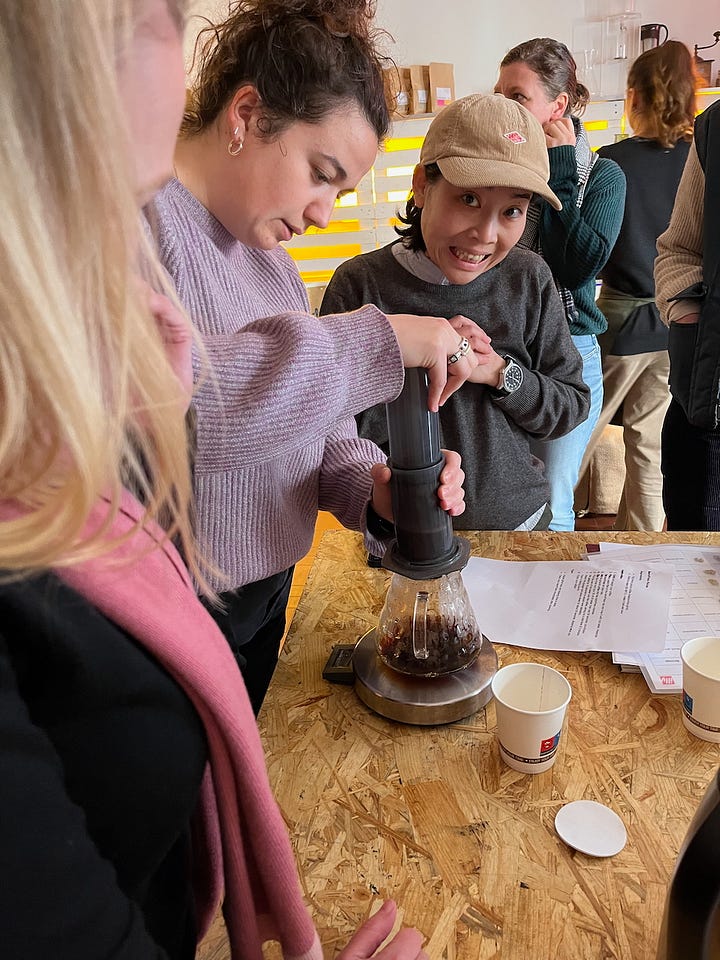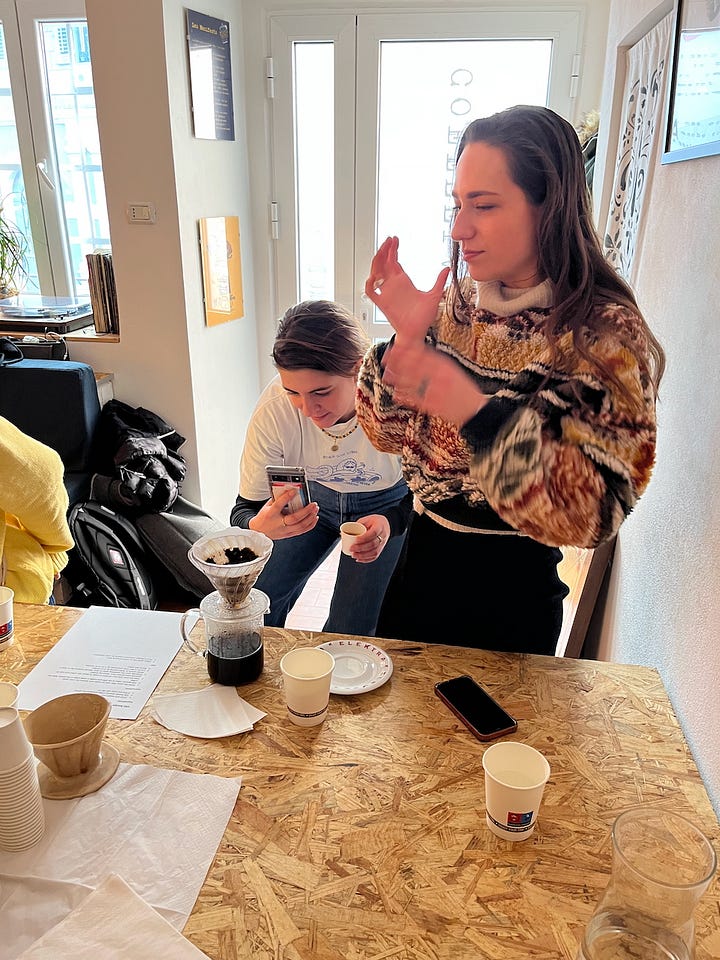Absolutely not one person likes the taste of coffee the first time they try it.
If you tried it as a child — it should go without saying I’m talking about straight black coffee, not with a whole lot of cream and sugar — your basic biology makes it taste gross. Years of evolution have taught us to crave sweet (energy) and dislike sour and bitter (possibly toxic) flavors, and those instincts are strong in children, so it’s a no-go from the start.
I know more than a few people who love the smell of coffee, but can’t stand the taste. Coffee is super complex, containing 1,000+ bioactive compounds, and when you drink it, you experience all of them. But only some of those compounds escape from the hot liquid into the air, and many (most?) people find that aroma pleasant. The “less pleasant” flavors stay in the cup.
As we get older, we still have that aversion to bitter tastes, but other forces start to take hold of us. Cultural and social pressures come into play, and we see others enjoying this potentially toxic brew, and we teach ourselves to like it. It’s a matter of brains over brawn — “In order to be accepted in society, I need to overcome this dislike and learn to like coffee.”
I hated coffee as a child, but as a teenager drank my first cup when my dad, after his unsuccessful run for the Minnesota state legislature, brought me to the capitol. We were in some state senator’s office and he offered us coffee, and how could I say no? I took it black, because I thought that would be better. I don’t remember exactly how I felt about it, because I was probably nervous just to be there, but I started drinking more after that, learned to enjoy it, and now it’s a morning ritual — coffee and contemplation.
Roughly 8 out of 10 Americans drink coffee (94% of French folk), and 6 of 10 Americans enjoy it daily. Worldwide more than 2.25 billion cups of coffee are consumed every day, making it the second only to tea (and not counting plain water).
But you’re probably drinking it wrong.
Which is why Bianca Maschio in Trieste, Italy, is trying to teach people — at least Italians — how to enjoy it properly.
“Italians have a deep coffee culture,” she explained to our class as we visited her coffee lab on our Friuli study trip, “but it’s very traditional and conservative. We invented the espresso machine and the moka pot, but we need to open up to other brewing methods.”
That starts with better understanding the long and highly complex supply chain that includes farmers, harvesters, intermediaries and exporters, roasters, distributors, retailers, and finally, consumers.
“We really should think of it as a luxury. It shouldn’t be here so easily,” adds Bianca. “It should cost more than one euro for that cup of espresso.”
Bianca, like every roaster, gets beans raw — they can be stored for up to a year without losing flavor. Most beans fall into two basic varieties: Arabica and Robusta. Arabica beans come from delicate, fussy plants, are highly aromatic and flavorful, and comprise about 70% of the coffee we consume. Robusta beans — tougher, more disease resistant, and easier to grow — contain more caffeine and antioxidants, and for some reason produces better crema, the nice foam you get on the top of your espresso. Bianca explained that Robusta have a more structure compared to Arabica.
The beans originated in Ethiopia, and are now also grown around the globe but close to the equator, in places like Brazil and Vietnam and Columbia. There are many different subspecies under both the Arabica and Robusta umbrellas (because biodiversity is important, right?), and they taste differently depending on where they’re grown (because terroir isn’t just for grapes and wine, right?).
She uses the mini-roaster in her lab to play with different beans from different areas, and experiments with time and temperature, to create a roasting curve and develop not just a perfect coffee, but the perfect coffee for each particular bean from each particular place.
I’m not going to pretend that I know what any of these lines mean, but I shared it with my friend Peter Cohen of Stringbean Coffee (full disclosure and shameless plug: we sell Stringbean at Kakao Chocolate, and use in it many confections, including our award-winning Turkish Coffee Truffle), who said this is close to what he’s done with his Columbian beans, but maybe more heat earlier and tapering off sooner with a higher final temp. (We’ll just leave the roasting to the experts, okay?)
Okay, so how are you (probably) drinking it wrong?
First, while the raw beans can keep for a year, roasted coffee beans start to lose their flavor immediately. So you need to make sure you’re getting coffee as close to the roasting date as possible. And you’re probably not going to get that from a big roaster sending it across the country, and you’ll have a better chance getting something local.
Which, as Bianca points out, is an ironic problem in Italy, where almost every café in the country uses one of three big roasters. I personally have only seen a couple coffee shops that use coffee from a small local roaster. In the US, however, we’re blessed with many, and we should enjoy their coffee more.
Next, that flavor loss is exponential after the beans are ground. Always get whole beans, and grind them yourself, otherwise half of that wonderful coffee flavor has already left the building.


Then there’s decaf. Sheesh.
“Decaffeinating coffee is a brutal process,” says Bianca. “They extract everything, separate the caffeine, and then put the aromatics back into the bean.”
Peter uses a less brutal method, Swiss Water Process, for Stringbean decaf, but still jokes that “decaf coffee is like making love in a canoe” because, well, you’re, um, enjoying something “pretty close to water.”
The preparation method also has a huge impact on the end result. Darker roasts perform better under pressure, like an espresso machine, moka pot, or French press, which extract more caffeine — but really still the same in total, because you’re drinking a smaller but more potent portion. Lighter roasts work better with more water, so do well with pourovers and drip coffee.
And about those double-shot-two-pumps-vanilla-half-whip-no-foam concoctions? Yes, they use coffee and contain some type of espresso, but can you really call them coffee anymore? I suppose so, if you’re going to count them in the 2.25 billion cups. But you really have no way to get through all that to get much more than a slight essence of the flavor of coffee.
Of course, how you prepare your coffee is obviously subjective and a matter of taste, and familiarity. But with each cup, we should be thinking about its journey. In what country was it grown? Who roasted it, and where? What type of bean is it? How was it roasted? That’s a lot, though.
So, no, we don’t need to know the provenance of every cup of coffee you drink. But we should be thinking about all the people and processes involved, and the journey our coffee took to get from a plant somewhere in the tropics into our hands and to touch our lips and to make us feel that special way, as only a cup of coffee can.
Then you’re drinking coffee the right way.
###
References (because I don’t just make this stuff up!):
The sweetness and bitterness of childhood: Insights from basic research on taste preferences
Why do some things, like fresh coffee, smell better than they taste?
Coffee Consumption – How Much is Too Much? And How Little is Not Enough?







